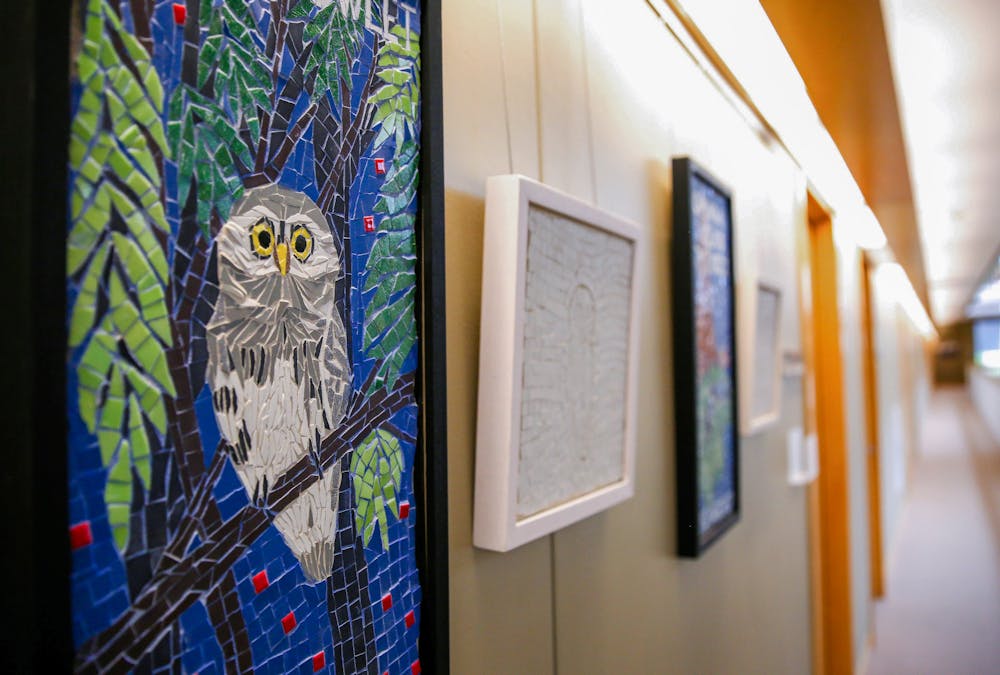This past month, the Art at Watson initiative opened a new exhibit titled “Endangered Animals and Their Ghosts: The Wish to Move Backward” at the Watson Institute for International and Public Affairs. The exhibit, created by local mosaic artist Jess Regelson, comprises a series of mosaics depicting endangered animals around the world and is set to appear on the second floor of the Watson’s 111 Thayer Street building until Dec.15.
Regelson’s series consists of colorful and intricate mosaics that portray 10 endangered animals in their natural habitats, each placed alongside smaller muted white-on-white mosaics that represent the “ghosts” of these animals — a picturesque warning of a world without them. In an artist’s statement presented beside the pieces, Regelson shared her wish to utilize the ancient art of mosaic to “urge people to consider (the animals’) absence” and to “declare the fragile status of each of these animals.”
Regelson said she started working on the series in 2019 after creating a mosaic of a pangolin; she soon began sketching other animals at high risk of extinction.
“I knew going into it that I wanted to not just depict the animal, but also find a way of showing what it would be like if they were utterly absent from the world,” Regelson said. “And that’s where the ghost images come in.”
Creating the ten animals and their accompanying ghosts took her two years, resulting in a poignant exhibit simultaneously celebrating nature’s wonders and mourning their loss before they’re gone.
The animals in the collection include various species like the forest owlet, humpback whale and Amur tiger. In addition to detailing each creature’s distinct physical features, Regelson seamlessly incorporates each animal into its surroundings, giving a lifelike presence to her mosaics. With the ghost mosaics, Regelson sticks to limited shades of white, stripping away from each animal the spirit it held in the preceding work.
Prior to her Watson exhibit, Regelson primarily worked with local schools across Rhode Island, creating mosaic murals for schoolchildren, as well as several other smaller series covering various subject matters, she said.
“I improved some skills working on this particular body of work,” said Regelson, referring to her animal mosaics. “Anytime we work in a series it gives you a chance to kind of figure out ways of saying something from a number of different angles.”
As a professional artist, Regelson was initially drawn to mosaics because she found them to be a “forgiving medium.”
“I can do things representationally or abstractly,” she said. Mosaics are “all about taking broken things and making a new whole out of what you’ve broken.” With her series, Regelson was able to further this dedication to recycling and rearrangement by creating mosaics that emphasize sustainability and reducing human interference in the environment.
Having submitted a proposal to the Art at Watson committee to display her work, Regelson believes that the Watson Institute's mission and the way it looks at the world from a global perspective, tackling issues like climate change and migration, aligns with the conservationist messages embedded in her work.
“If (the exhibit) leads to some kind of an action on the part of the people who see (it), that would please me enormously,” she said.
Art at Watson, an initiative that began in 2012, aims to promote the institute’s mission of creating a “just and peaceful world” by featuring local and international artists, according to the Watson Institute’s website. The initiative aims for the artistic voices featured to inspire a genuine motivation for change and spark conversation amongst visitors and other members of the community.
Dr. Pete Bilderback, the Watson Institute's communications and outreach specialist who serves on the Art at Watson committee, emphasized how Regelson’s mosaics highlight a unique way of studying humanity. Referring to the years of influence and histories that mosaics hold as an ancient art form, he said, “Jess’s exhibit invites us to take a step back and look critically at ourselves in our own society … even potentially imagine you are looking at the exhibit from some distant point in the future.”
“This is not artwork that fades into the background,” Bilderback said. “It really invites you to stop and contemplate it.”
Logan Hines ’26, who viewed the mosaic collection, felt similarly. “It’s interesting to see how each piece is replicated and it makes you really focus on the subject,” he said. “It’s just a really interesting way of thinking about what impact we have on the endangerment of species in the world.”
“Many of these animals are in danger because of changes to the planet that are happening due to human activity,” Bilderback said. “We want people to think about our role on this planet and what we’re doing to it, and what we could be doing differently.”
Isabel Hahn is an Arts & Culture editor who concentrates in English and Behavioral Decision Sciences. In her free time, she enjoys watching movies, reading, and journaling.





